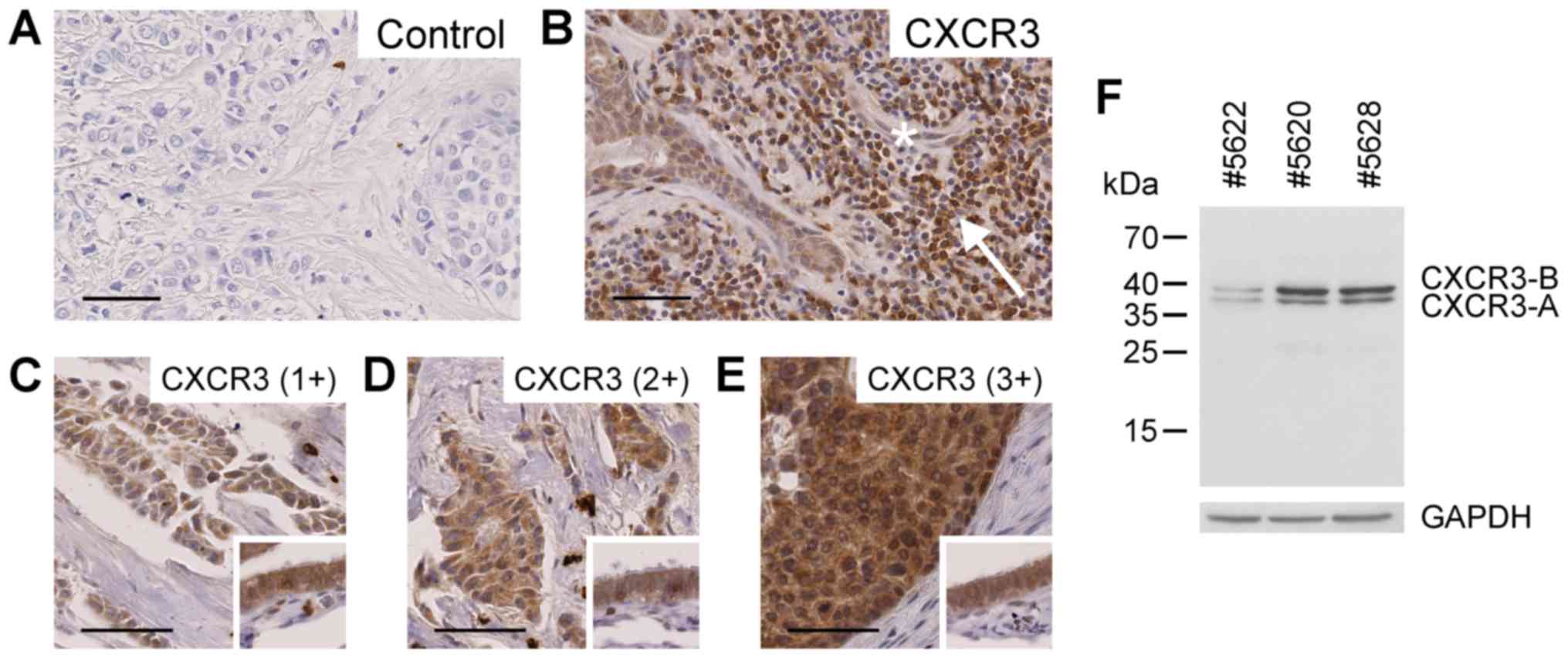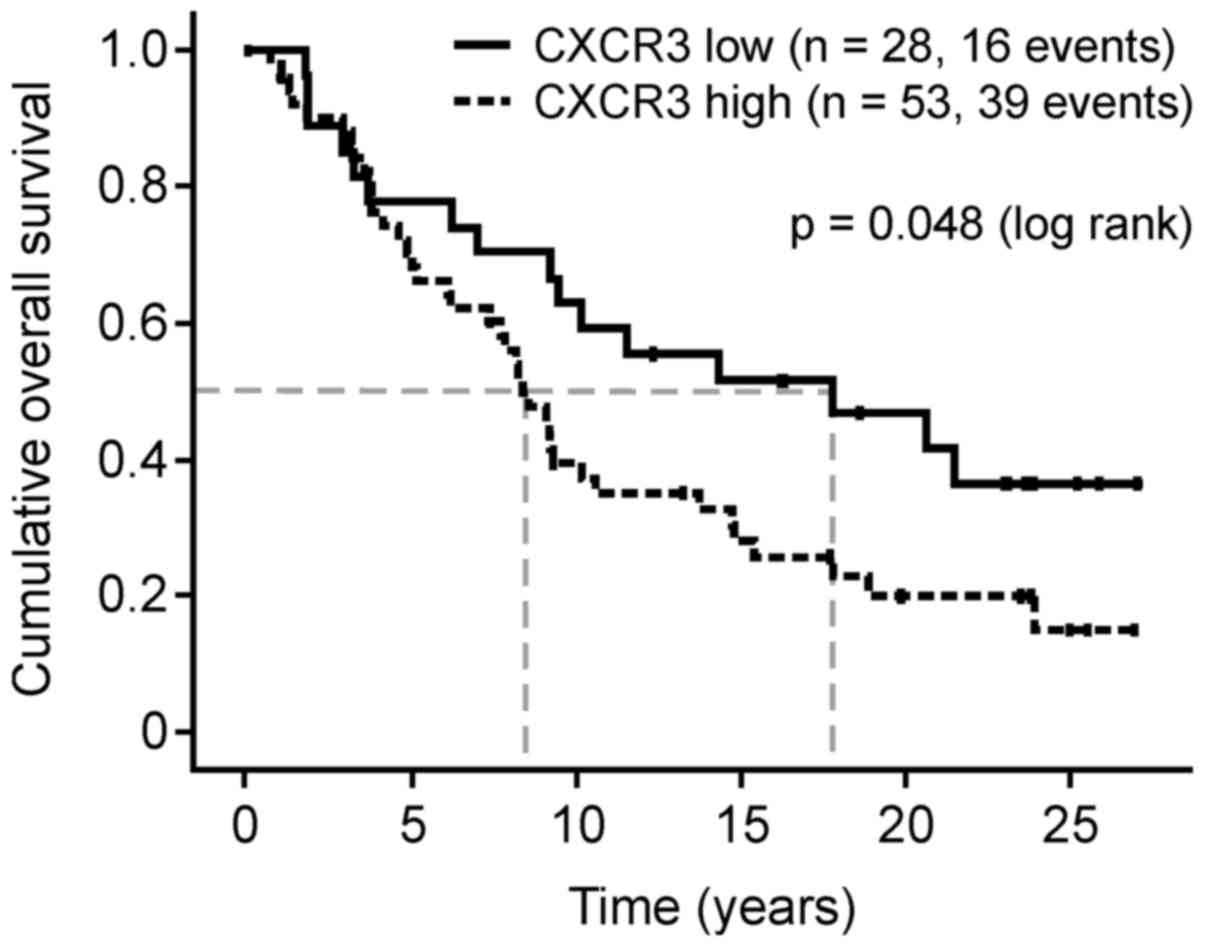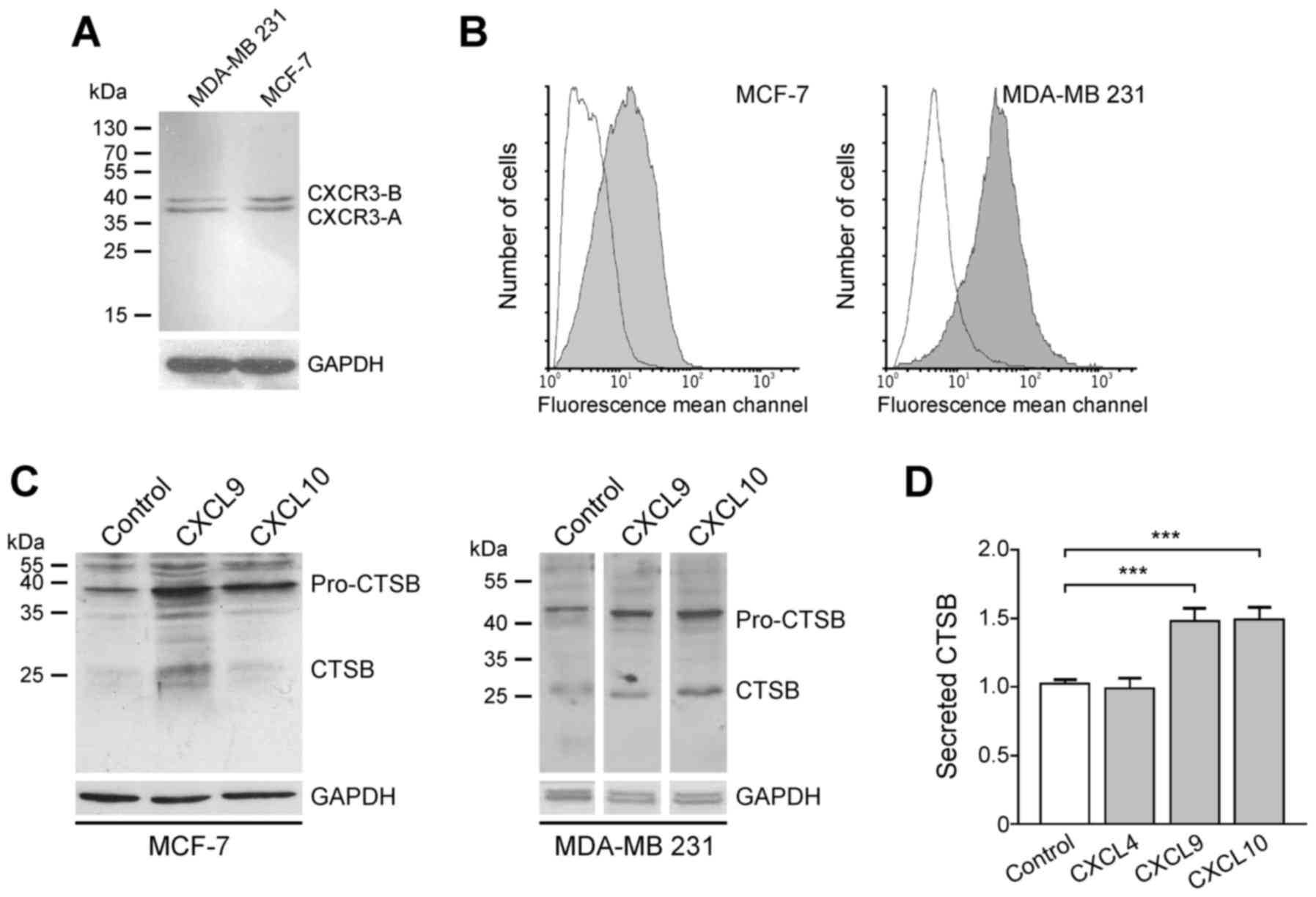|
1
|
Yan S and Sloane BF: Molecular regulation
of human cathepsin B: Implication in pathologies. Biol Chem.
384:845–854. 2003. View Article : Google Scholar : PubMed/NCBI
|
|
2
|
Roshy S, Sloane BF and Moin K:
Pericellular cathepsin B and malignant progression. Cancer
Metastasis Rev. 22:271–286. 2003. View Article : Google Scholar : PubMed/NCBI
|
|
3
|
Aggarwal N and Sloane BF: Cathepsin B:
Multiple roles in cancer. Proteomics Clin Appl. 8:427–437. 2014.
View Article : Google Scholar : PubMed/NCBI
|
|
4
|
Olson OC and Joyce JA: Cysteine cathepsin
proteases: Regulators of cancer progression and therapeutic
response. Nat Rev Cancer. 15:712–729. 2015. View Article : Google Scholar : PubMed/NCBI
|
|
5
|
Kos J, Mitrović A and Mirković B: The
current stage of cathepsin B inhibitors as potential anticancer
agents. Future Med Chem. 6:1355–1371. 2014. View Article : Google Scholar : PubMed/NCBI
|
|
6
|
Vasiljeva O, Korovin M, Gajda M, Brodoefel
H, Bojic L, Krüger A, Schurigt U, Sevenich L, Turk B, Peters C and
Reinheckel T: Reduced tumour cell proliferation and delayed
development of high-grade mammary carcinomas in cathepsin
B-deficient mice. Oncogene. 27:4191–4199. 2008. View Article : Google Scholar : PubMed/NCBI
|
|
7
|
Vasiljeva O, Papazoglou A, Krüger A,
Brodoefel H, Korovin M, Deussing J, Augustin N, Nielsen BS, Almholt
K, Bogyo M, et al: Tumor cell-derived and macrophage-derived
cathepsin B promotes progression and lung metastasis of mammary
cancer. Cancer Res. 66:5242–5250. 2006. View Article : Google Scholar : PubMed/NCBI
|
|
8
|
Lah TT, Cercek M, Blejec A, Kos J,
Gorodetsky E, Somers R and Daskal I: Cathepsin B, a prognostic
indicator in lymph node-negative breast carcinoma patients:
Comparison with cathepsin Dcathepsin L, and other clinical
indicators. Clin Cancer Res. 6:578–584. 2000.PubMed/NCBI
|
|
9
|
Thomssen C, Schmitt M, Goretzki L, Oppelt
P, Pache L, Dettmar P, Jänicke F and Graeff H: Prognostic value of
the cysteine proteases cathepsins B and cathepsin L in human breast
cancer. Clin Cancer Res. 1:741–746. 1995.PubMed/NCBI
|
|
10
|
Maguire TM, Shering SG, Duggan CM,
McDermott EW, O'Higgins NJ and Duffy MJ: High levels of cathepsin B
predict poor outcome in patients with breast cancer. Int J Biol
Markers. 13:139–144. 1998.PubMed/NCBI
|
|
11
|
Foekens JA, Kos J, Peters HA, Krasovec M,
Look MP, Cimerman N, Meijer-van Gelder ME, Henzen-Logmans SC, van
Putten WL and Klijn JG: Prognostic significance of cathepsins B and
L in primary human breast cancer. J Clin Oncol. 16:1013–1021. 1998.
View Article : Google Scholar : PubMed/NCBI
|
|
12
|
Harbeck N, Alt U, Berger U, Krüger A,
Thomssen C, Jänicke F, Höfler H, Kates RE and Schmitt M: Prognostic
impact of proteolytic factors (urokinase-type plasminogen
activator, plasminogen activator inhibitor 1, and cathepsins B, D,
and L) in primary breast cancer reflects effects of adjuvant
systemic therapy. Clin Cancer Res. 7:2757–2764. 2001.PubMed/NCBI
|
|
13
|
Balaji KN, Schaschke N, Machleidt W,
Catalfamo M and Henkart PA: Surface cathepsin B protects cytotoxic
lymphocytes from self-destruction after degranulation. J Exp Med.
196:493–503. 2002. View Article : Google Scholar : PubMed/NCBI
|
|
14
|
Hasan L, Mazzucchelli L, Liebi M, Lis M,
Hunger RE, Tester A, Overall CM and Wolf M: Function of liver
activation-regulated chemokine/CC chemokine ligand 20 is
differently affected by cathepsin B and cathepsin D processing. J
Immunol. 176:6512–6522. 2006. View Article : Google Scholar : PubMed/NCBI
|
|
15
|
Repnik U, Starr AE, Overall CM and Turk B:
Cysteine cathepsins activate ELR chemokines and inactivate non-ELR
chemokines. J Biol Chem. 290:13800–13811. 2015. View Article : Google Scholar : PubMed/NCBI
|
|
16
|
Chen DS and Mellman I: Oncology meets
immunology: The cancer-immunity cycle. Immunity. 39:1–10. 2013.
View Article : Google Scholar : PubMed/NCBI
|
|
17
|
Wendel M, Galani IE, Suri-Payer E and
Cerwenka A: Natural killer cell accumulation in tumors is dependent
on IFN-gamma and CXCR3 ligands. Cancer Res. 68:8437–8445. 2008.
View Article : Google Scholar : PubMed/NCBI
|
|
18
|
da Silva R Barreira, Laird ME, Yatim N,
Fiette L, Ingersoll MA and Albert ML: Dipeptidylpeptidase 4
inhibition enhances lymphocyte trafficking, improving both
naturally occurring tumor immunity and immunotherapy. Nat Immunol.
16:850–858. 2015. View
Article : Google Scholar : PubMed/NCBI
|
|
19
|
Shin SY, Nam JS, Lim Y and Lee YH:
TNFα-exposed bone marrow-derived mesenchymal stem cells promote
locomotion of MDA-MB-231 breast cancer cells through
transcriptional activation of CXCR3 ligand chemokines. J Biol Chem.
285:30731–30740. 2010. View Article : Google Scholar : PubMed/NCBI
|
|
20
|
Zipin-Roitman A, Meshel T, Sagi-Assif O,
Shalmon B, Avivi C, Pfeffer RM, Witz IP and Ben-Baruch A: CXCL10
promotes invasion-related properties in human colorectal carcinoma
cells. Cancer Res. 67:3396–3405. 2007. View Article : Google Scholar : PubMed/NCBI
|
|
21
|
Jänicke F, Pache L, Schmitt M, Ulm K,
Thomssen C, Prechtl A and Graeff H: Both the cytosols and detergent
extracts of breast cancer tissues are suited to evaluate the
prognostic impact of the urokinase-type plasminogen activator and
its inhibitor, plasminogen activator inhibitor type 1. Cancer Res.
54:2527–2530. 1994.PubMed/NCBI
|
|
22
|
Bronger H, König J, Kopplow K, Steiner HH,
Ahmadi R, Herold-Mende C, Keppler D and Nies AT: ABCC drug efflux
pumps and organic anion uptake transporters in human gliomas and
the blood-tumor barrier. Cancer Res. 65:11419–11428. 2005.
View Article : Google Scholar : PubMed/NCBI
|
|
23
|
Bronger H, Kraeft S, Schwarz-Boeger U,
Cerny C, Stöckel A, Avril S, Kiechle M and Schmitt M: Modulation of
CXCR3 ligand secretion by prostaglandin E2 and cyclooxygenase
inhibitors in human breast cancer. Breast Cancer Res. 14:R302012.
View Article : Google Scholar : PubMed/NCBI
|
|
24
|
Kaplan EL and Meier P: Nonparametric
estimation from incomplete observations. J Amer Statist Assn.
53:457–481. 1958. View Article : Google Scholar
|
|
25
|
Datta D, Flaxenburg JA, Laxmanan S, Geehan
C, Grimm M, Waaga-Gasser AM, Briscoe DM and Pal S: Ras-induced
modulation of CXCL10 and its receptor splice variant CXCR3-B in
MDA-MB-435 and MCF-7 cells: Relevance for the development of human
breast cancer. Cancer Res. 66:9509–9518. 2006. View Article : Google Scholar : PubMed/NCBI
|
|
26
|
Ma X, Norsworthy K, Kundu N, Rodgers WH,
Gimotty PA, Goloubeva O, Lipsky M, Li Y, Holt D and Fulton A: CXCR3
expression is associated with poor survival in breast cancer and
promotes metastasis in a murine model. Mol Cancer Ther. 8:490–498.
2009. View Article : Google Scholar : PubMed/NCBI
|
|
27
|
Cerny C, Bronger H, Davoodi M, Sharma S,
Zhu L, Obana S, Sharma J, Ebrahimi R, St John M, Lee JM, et al: The
role of CXCR3/ligand axis in cancer. International Trends in
Immunity. 3:46–52. 2015. View Article : Google Scholar
|
|
28
|
Ma B, Khazali A and Wells A: CXCR3 in
carcinoma progression. Histol Histopathol. 30:781–792.
2015.PubMed/NCBI
|
|
29
|
Denkert C, Loibl S, Noske A, Roller M,
Müller BM, Komor M, Budczies J, Darb-Esfahani S, Kronenwett R,
Hanusch C, et al: Tumor-associated lymphocytes as an independent
predictor of response to neoadjuvant chemotherapy in breast cancer.
J Clin Oncol. 28:105–113. 2010. View Article : Google Scholar : PubMed/NCBI
|
|
30
|
Denkert C, von Minckwitz G, Brase JC, Sinn
BV, Gade S, Kronenwett R, Pfitzner BM, Salat C, Loi S, Schmitt WD,
et al: Tumor-infiltrating lymphocytes and response to neoadjuvant
chemotherapy with or without Carboplatin in human epidermal growth
factor receptor 2-positive and triple-negative primary breast
cancers. J Clin Oncol. 33:983–991. 2015. View Article : Google Scholar : PubMed/NCBI
|
|
31
|
Specht K, Harbeck N, Smida J, Annecke K,
Reich U, Naehrig J, Langer R, Mages J, Busch R, Kruse E, et al:
Expression profiling identifies genes that predict recurrence of
breast cancer after adjuvant CMF-based chemotherapy. Breast Cancer
Res Treat. 118:45–56. 2009. View Article : Google Scholar : PubMed/NCBI
|
|
32
|
Dorsey R, Kundu N, Yang Q, Tannenbaum CS,
Sun H, Hamilton TA and Fulton AM: Immunotherapy with interleukin-10
depends on the CXC chemokines inducible protein-10 and monokine
induced by IFN-gamma. Cancer Res. 62:2606–2610. 2002.PubMed/NCBI
|
|
33
|
Walser TC, Ma X, Kundu N, Dorsey R,
Goloubeva O and Fulton AM: Immune-mediated modulation of breast
cancer growth and metastasis by the chemokine Mig (CXCL9) in a
murine model. J Immunother. 30:490–498. 2007. View Article : Google Scholar : PubMed/NCBI
|
|
34
|
Walser TC, Rifat S, Ma X, Kundu N, Ward C,
Goloubeva O, Johnson MG, Medina JC, Collins TL and Fulton AM:
Antagonism of CXCR3 inhibits lung metastasis in a murine model of
metastatic breast cancer. Cancer Res. 66:7701–7707. 2006.
View Article : Google Scholar : PubMed/NCBI
|
|
35
|
Yang J, Mani SA, Donaher JL, Ramaswamy S,
Itzykson RA, Come C, Savagner P, Gitelman I, Richardson A and
Weinberg RA: Twist, a master regulator of morphogenesis, plays an
essential role in tumor metastasis. Cell. 117:927–939. 2004.
View Article : Google Scholar : PubMed/NCBI
|
|
36
|
Hilborn E, Sivik T, Fornander T, Stål O,
Nordenskjöld B and Jansson A: C-X-C ligand 10 and C-X-C receptor 3
status can predict tamoxifen treatment response in breast cancer
patients. Breast Cancer Res Treat. 145:73–82. 2014. View Article : Google Scholar : PubMed/NCBI
|
|
37
|
Wolf K and Friedl P: Mapping proteolytic
cancer cell-extracellular matrix interfaces. Clin Exp Metastasis.
26:289–298. 2009. View Article : Google Scholar : PubMed/NCBI
|
|
38
|
Van den Steen PE, Husson SJ, Proost P, Van
Damme J and Opdenakker G: Carboxyterminal cleavage of the
chemokines MIG and IP-10 by gelatinase B and neutrophil
collagenase. Biochem Biophys Res Commun. 310:889–896. 2003.
View Article : Google Scholar : PubMed/NCBI
|
|
39
|
Denney H, Clench MR and Woodroofe MN:
Cleavage of chemokines CCL2 and CXCL10 by matrix
metalloproteinases-2 and −9: Implications for chemotaxis. Biochem
Biophys Res Commun. 382:341–347. 2009. View Article : Google Scholar : PubMed/NCBI
|
|
40
|
Zhu G, Yan HH, Pang Y, Jian J, Achyut BR,
Liang X, Weiss JM, Wiltrout RH, Hollander MC and Yang L: CXCR3 as a
molecular target in breast cancer metastasis: Inhibition of tumor
cell migration and promotion of host anti-tumor immunity.
Oncotarget. 6:43408–43419. 2015.PubMed/NCBI
|












